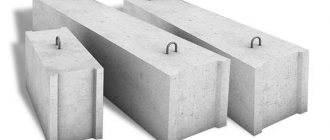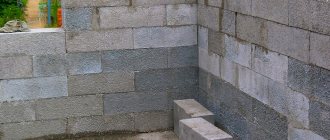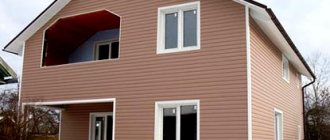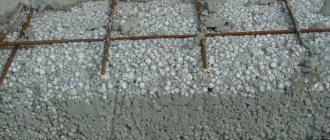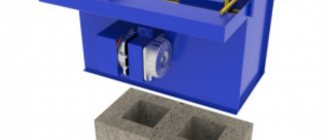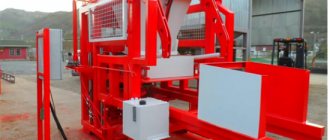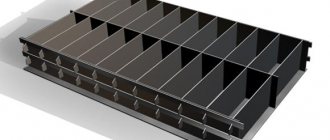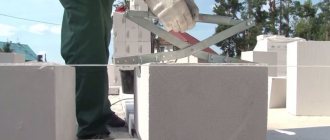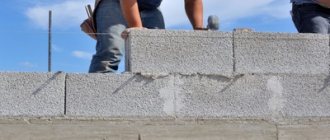For the production of polystyrene concrete building blocks, foam granules in bulk form are used as coarse aggregate, as well as other types of polystyrene foam ground to a certain fraction.
Ingredients for cooking
To obtain polystyrene concrete blocks you need:
- Portland cement grade M400-500;
- washed river fine-grained quartz sand;
- clean water, preferably from the main water supply;
- foamed, unconnected polystyrene foam granules or large crumbs of ground polystyrene foam.
The initial components are mixed in a mixer and poured into molds (formwork) pre-lubricated from the inside.
For lubrication, an emulsion of diesel fuel (kerosene) and stearin (paraffin) in a ratio of 15: 1 is usually used.
The mass, density and strength of the blocks depend on the number of polystyrene foam granules , in a ratio with cement from 3 to 8 of the volume of cement. The proportion of cement and sand is 1:3.
Plasticizing additives can be added to the liquid composition for polystyrene concrete during mixing in a proportion of 1-3% of the volume, increasing its workability, as well as frost resistance and water resistance (waterproofing agents).
Comparative characteristics of various building materials
| Material | Density, kg/m3 | Coefficient thermal conductivity, W/(m*C) | heat loss, W/m2 | Wall thickness at Ropr=3.15, m | Weight of 1m2 wall, kg |
| Solid clay brick | 1700 | 0,81 | 54 | 2,55 | 4337,55 |
| Clay brick (20% hollowness) | 1400 | 0,43 | 28,67 | 1,35 | 1896,3 |
| Silicate brick | 1800 | 0,87 | 58 | 2,74 | 4932,9 |
| Cellular concrete (autoclaved) | 550 | 0,18 | 17,5 | 0,55 | 303,19 |
| Expanded clay concrete | 850 | 0,38 | 26,67 | 1,18 | 1004,06 |
| Tree | 500 | 0,15 | 33,33 | 0,47 | 236,25 |
| POLYSTYRENE CONCRETE | 450 | 0,13 | 13,33 | 0,30 | 135 |
Tools and equipment
Needed for work:
- shovel;
- hammer-pick;
- roulette;
- construction square;
- mason's trowel (trowel);
- spatulas of different widths;
- paint brushes or flange brushes for applying a release agent to the formwork;
- scales;
- measuring utensils - buckets and other containers of a given volume;
- electric concrete mixer of drum or auger type with a volume of 100 to 300 liters;
- electric winch or hoist for supplying concrete during pouring;
- steam generator for foaming polystyrene granules;
- mixer grinder for recycling foam waste;
- To better compact the mixture, sometimes a vibrating table is organized, for which the work area is covered with tin and a vibrating mace or vibrating lath is attached to it.
In the absence of vibration compaction, the finished product may turn out to be loose, containing undeveloped areas in the corners of forms or formworks.
More details about what equipment is needed to create polystyrene concrete blocks can be found in this material.
Forms and formwork
Forms or formwork for products are made of waterproof chipboards, plywood, sheet plastic or metal with stiffeners in individual (separately for each block) or cassette (for simultaneous production of several blocks) design.
To simplify forming, the formwork is made easily dismountable , using clamps, bolts, studs with nuts.
If necessary, the molds can have inventory inserts to form one or more cavities (voids), reducing the volumetric weight of the product. Inserts of a different configuration may be required for molding corner, additional products, butt edges with special cutouts for openings, which are called quarters.
Organization and placement of manual production
The production site, with communications connected to it - water supply and electrical networks, is located next to the construction site. The place of production and storage is protected from atmospheric influences by a light awning.
In order for the blocks to gain their design strength by the time of laying, work should begin as soon as the minimum daily temperature begins to exceed 5 °C .
Useful tips
Strength depends on the granules used in polystyrene concrete.
The strength of polystyrene concrete material will depend on what granules are used. Experts have different opinions on this matter. Some recommend either purchasing crushed building material, or making your own device designed for “cutting” foam plastic. Thus, you will be able to save half as much money, since the cost of the prepared ingredient is quite high.- For private construction work, it is better to prepare two different solutions, the density of which should be 350 and 1200 kilograms per cubic meter. The first can be used to build partitions, create screeds, and use it as insulation. The second solution is perfect for building walls that are subject to strong pressure.
- If the operating conditions of the building material comply with the prescribed standards, the strength will increase over time.
- It is desirable that when mixing the density of the thermal insulation solution is D200.
Return to contents
Home making process
Let's take a closer look at how polystyrene concrete blocks are created.
Using improvised means
The easiest way to make polystyrene wall blocks is by hand. It may contain the following sequence of actions:
- Procurement and delivery of materials and ingredients, including foamed polystyrene granules.
Making forms (formworks) from boards or plywood.
If there are several formworks, you need to ensure that the blocks cast in it have similar dimensions, and you also need to ensure that the walls are parallel and perpendicular.- Making a comfortable desktop.
- Connecting a concrete mixer. Manual mixing of the solution using shovels is only suitable for the construction of secondary buildings - a garage, barn, chicken coop, bathhouse.
- Lubricating the formwork inside with paraffin-kerosene emulsion.
- Preparation of liquid polystyrene concrete mortar in the proportion of components required for a particular class of strength, density, frost resistance, water permeability and laying it in formwork.
- Compacting the solution (the easiest way to do this is by lifting the form above the work table at least 10-15 times and sharply lowering it onto its surface with a knock).
- Transferring the mold to a place of temporary storage for maintenance and initial strength gain.
- After a week, the mold can be disassembled and prepared for the next cycle of use, and the block can be transferred to a permanent warehouse for a 3-week development of design strength and subsequent use.
On special equipment
Typically, such equipment is purchased or leased . In this case, the labor of trained workers, as well as an invited technologist-consultant, is used, acting according to certain instructions and technological maps developed for this type of mechanism.
The relationship between classes and grades of polystyrene concrete in terms of compressive strength
| Concrete strength class | Average concrete strength R, MPa | Closest brand in terms of strength |
| B0.5 | 0,73 | M7.5 |
| B0.75 | 1,09 | M10 |
| B1.0 | 1,45 | M15 |
| B1.5 | 2,16 | M20 |
| B2.0 | 2,90 | M25 |
| B2.5 | 3,60 | M35 |
Advantages and disadvantages
Positive qualities include:
- Manufacturing speed.
- Excellent physical characteristics and ability to resist all-season adverse weather conditions.
- Environmental friendliness of both initial components and finished products.
- The large size of the blocks reduces the time for laying walls.
- Reducing the volume of excavation work during construction, since masonry from light blocks significantly reduces the load on the foundation and allows you to narrow the width of its base.
- Frost resistance.
- Low water absorption.
- Excellent waterproofing and noise-proof properties.
To negative:
- The need for constant careful monitoring of compliance with geometric dimensions.
- Deterioration of the formwork, making replacement necessary (the cost of its depreciation and turnover).
- Obtaining in mixers, usually intended for domestic use, a homogeneous mass with a given strength for the finished product.
- Mandatory temporary care of finished blocks.
- Difficulties in the absence of a heated room with the work of making blocks during the cold season, accompanied by negative temperatures.
- The need to finish the front surface of the masonry - plaster, tiling with natural or artificial stone, cladding with metal or polymer stamped siding.
- The need for a nearby plastics plant that sells granules for polystyrene foam. Otherwise, the costs of delivering it from other regions may be prohibitively high.
What should you consider when working with polystyrene concrete?
– It is not recommended to work with ordinary screws, dowels and anchors, because they will not adhere well to polystyrene concrete (due to its porous structure). It is necessary to use special screw dowels or chemical anchors .
– Particular attention should be paid to the installation of windows and doors in the openings. If installed incorrectly, windows and doors may become unstable.
– Be sure to follow the production technology ! The composition of the mixture must correspond to the recipe and have the required number of polystyrene granules (granules diameter more than 2 mm). You can buy foam balls without any problems in Russia, Kazakhstan, Uzbekistan and other CIS countries.
– Do not allow the blocks to come into contact with acetone and gasoline - there is a high risk of damage.
What is the cost?
This is one of the most important questions that usually worries the owner of a plot of land who wants to start manufacturing polystyrene concrete blocks for building his house.
When calculating and summing up unit prices for constituent materials and components, we obtain the cost of 1 m3 of about 4,300 rubles .
The volume of one block with standard dimensions is 0.016 m3. Having calculated the proportion for one block, we find that its cost will be about 65 rubles.
Manufacturers of polystyrene concrete stones
There are several manufacturers of polystyrene concrete blocks on the Russian market:
- The concrete block plant is located in Crimea, in the city of Simferopol. Engaged in the sale and production of building materials of various sizes, there is delivery throughout the regions.
- Plastblock is a manufacturer from Yekaterinburg. It has been operating for more than 20 years, producing not only blocks, but also lintels and reinforced slabs from the specified material.
- Ermak is a plant from Chelyabinsk. It works according to standards, has all the certificates and expert opinions, the goods are distributed throughout the territory of the Customs Union.
- PromstroyPenoplast is a manufacturer from Moscow. Produces material and delivers it to surrounding areas. You can order large quantities for large-scale construction.
- Polystyrene concrete plant from the Sverdlovsk region. Products are manufactured according to certificates, fast delivery, 18 years of experience.
Almost every region of Russia has its own manufacturers of this material, so ordering it will not be difficult.
